The Good and Evil Serpent (25 page)
Read The Good and Evil Serpent Online
Authors: James H. Charlesworth

Figure 39
. Two Rings from Jerusalem and the Roman Period. The ring on the left is silver and shown previously, the one on the right is bronze. The left serpent ring depicts the eyes and mouths of the serpents. The one on the right is more stylized, but horizontal lines depict the serpent’s skin. Most likely the head of the serpent was broken off. JHC Collection
The bronze earring in
Fig. 40
shows a serpent with large eyes. It dates from the Roman Period and was found in or near Jerusalem.
260
Because of its quality, the work probably belonged to a wealthy person. The jewelry or clasp shows dragons.
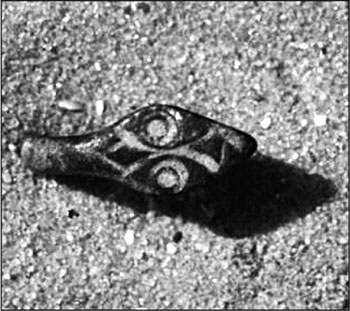
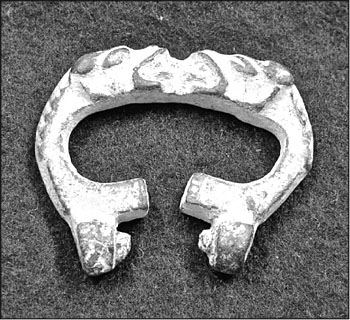
Figure 40
.
Left
. Bronze Earring Showing Serpent with Large Eyes. Early Roman Period. From in or near Jerusalem. JHC Collection
Figure 41
.
Right
. Bronze Jewelry. Roman Period. Jerusalem. Probably a Persian dragon with mouth, ears, and eyes. JHC Collection
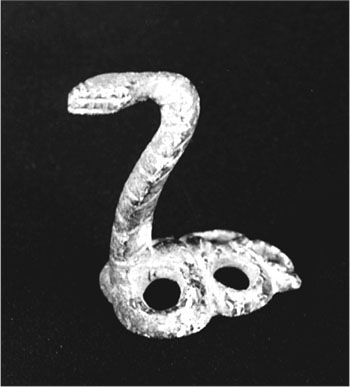
Figure 42
. Bronze Upraised Serpent. JHC Collection
Figure 42
is an anguine symbol found in the environs of Jerusalem, probably dating from the Roman Period. It is an upright bronze serpent. Perhaps it was once part of wooden furniture.
The previous discussion can only represent some selected examples of the abundance of serpent jewelry from antiquity. It is clear that the serpent—perhaps more than any other animal—was chosen to adorn jewelry and make wearers more attractive.
261
Note the following table of gold jewelry with serpents; all date from between 100
BCE
and 100
CE
(the date for the final editing of the Fourth Gospel, without the latter addition of 7:53–8:11; also see the additions in
Appendix III
):
262
Table 1
. A Selection of Roman Era Gold Jewelry with Serpents
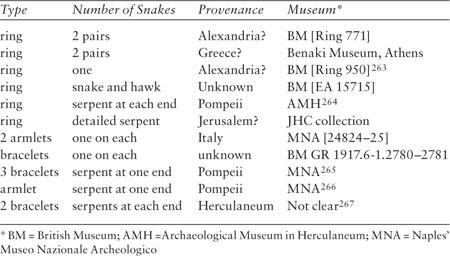
One should also recall the earlier discussion and picture of the Greek-Scythian gold serpent goddess image that was made for the forehead of a horse (fourth cent.
BCE
).
268
ARCHAEOLOGICAL EVIDENCE OF ROMAN GLASS AND OPHIDIAN ICONOGRAPHY
During the Hellenistic Period, glass flasks, beakers, and goblets appeared with monochrome threads. This artwork is categorized as “snake-thread” decoration. The glass is applied to the outside of the vessel. The snakethread ornamentation winds like a serpent and often has slanting indentations. Occasionally, these snake-threads are strikingly reminiscent of serpents clearly applied to other vessels.
269
It seems that the technique of decorating glass with snake-thread designs originated sometime in the early first century
BCE
or
CE
in the eastern area of the Mediterranean.
270
Most of the examples date from the second or third centuries
CE
.
271
Although fragments of snake-thread glass were found at Dura-Europos,
272
the provenance of a piece is frequently unknown.
273
Decoration of another type, which is also evocative of serpents, appears on glassware. It is glass with bifurcated ribs, or pinched ribbed glass (not pinched thread glassware).
274
The parison (preliminary shape) of the vessel is pinched during the earliest stages of blowing. This time the design on the glass is not always easy to distinguish from the caduceus or two serpents that rise, sometimes around a central rod, and almost always face each other.
275
Some of the glass with bifurcated ribs clearly was made in the glass factory at Jalame,
276
a northeast foothill of Mount Carmel,
277
during the first centuries of the Common Era. Examples were found at Dura-Europos.
278
The snake-thread and the pinched-rib decorations on Roman glass are intended to make the glass more attractive.
While these markings reflect knowledge of serpents and perhaps of ophidian iconography, they must not be interpreted as an example of serpent symbolism. Although the “snake-thread” decorations are mere ornamentations, we should allow for the possibility that serpents appeared on glass, yet this assumption is denied in recent publications. We should be open to the possibility that serpents were depicted on glass, if only ideally or impressionistically. We have seen that serpent iconography was ubiquitous in the Hellenistic Period. Giants were depicted having anguipedes. Gods and goddesses—especially Apollo, Asclepius, Hygieia, and Isis—appeared as serpents. Actors, poets, and soldiers were hailed as heroic because of the presence of a serpent on a monument.
279
Romans originally were not fond of glassware, but, beginning with the new imperial iconography established during the reign of Augustus (37
BCE
–14
CE
) and the development of slave trade routes, glass became popular in the West as it had been formerly in the East. Glassblowing was discovered (or invented) in the East (Syria, including Judaea), and many of these craftsmen may have migrated to Italy. By the late first century
BCE
, Horace could refer to a spring on his villa as “more sparkling than glass”
(splendidior vitro)
.
280
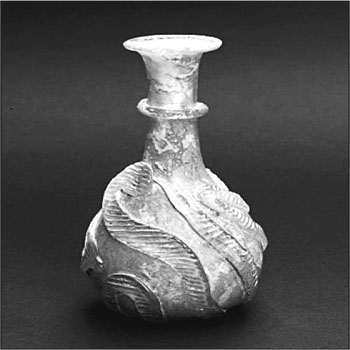
Figure 43
. Glass Bottle with Serpent Appliqué. Serpents are upraised and eyes are prominent. First century BCE. From Hizma, northeast of Jerusalem. JHC Collection
Now I will introduce a sensational discovery; it will become certain that serpents were depicted on glass (see
Fig. 43
).
281
This glass was found allegedly at Hizma, which is less than 8 kilometers northeast of Jerusalem.
282
Two serpents are clearly depicted.
283
This decoration is quite unlike the ornamentations that appear on the necks of beakers or jugs.
284
The serpents are appliquéd glass. While a somewhat similar example is preserved in the Israel Museum,
285
on the present piece of glass two serpents are indisputably depicted. Their heads are obviously those of a serpent; the eye is noticeably present, and the skin is depicted by lines. Both serpents are upright, as if they are aroused cobras. One is reminded of the uraeus and the imagery of Numbers 21 and John 3:14.
ARCHAEOLOGICAL EVIDENCE FOR “PAGAN” CULTS EMPLOYING SERPENT SYMBOLOGY
An Asclepian Cult in Jerusalem?
We can once again return to the search for ophidian objects in and near Jerusalem. It is becoming clear that there was a temple to Asclepius in Bethesda (Bethzatha) that is just inside Jerusalem and north of the Sheep’s Gate (Stephen’s Gate, Lion’s Gate). There probably also was an Asklepieion with healing baths and a room for incubation.
286
Stones from a temple to Asclepius have been uncovered near the Church of Saint Anne (surely, as Saladin knew, one of the masterpieces of the Crusader Period). To the northeast of it are vaulted rooms, which most likely had columns (stoa as suggested by Jn 5), and a private pool. This pool is neither a cistern nor a mikveh (ritual cleansing bath). Stratigraphy, coins, and pottery indicate that these installations were in place during the time of Aelia Capitolina, Hadrian’s name for the city that replaced Jerusalem, or after 135/36
CE
. It is probable that the Asclepian cult was active here before 132 and after 70
CE
. There were healing groups congregated there for centuries before the destruction of 70
CE
, and these would not threaten or be threatened by the sanctity of the Temple and the power of the Sadducees.
The stratification is dated by coins and sherds. The area was occupied prior to 135/36
CE
. The best evidence for the presence of a cult of Asclepius comes from the post-135/36 period, but there is reason to think that the healing cult of this god goes back to an earlier period. There were healing cults in this area of Jerusalem long before 70
CE
.